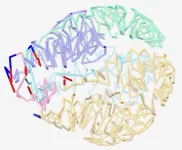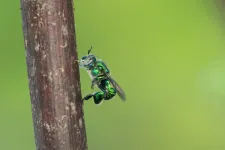(Press-News.org) In the run-up to the 2020 election, people appear to have become savvier in spotting misinformation online: clicks onto unreliable websites have declined, according to a new Stanford study published April 13 in the journal Nature Human Behaviour. According to prior research, some 44.3 percent of Americans visited websites during the 2016 U.S. election that repeatedly made false or misleading information.
During the 2020 election, Stanford scholars saw that number drop by nearly half to 26.2 percent.
While these findings are promising, the scholars are cautious in interpreting the study’s results. Exposure even among fewer people can still have serious consequences, they noted in the paper. Extrapolating their results, the scholars estimated that nearly 68 million Americans made a total of 1.5 billion visits to untrustworthy websites during the 2020 election.
“Although we saw a serious reduction in the overall number of people exposed to misinformation on the web, misinformation remains a serious problem in the information ecosystem for some populations, especially older adults and diverse communities,” said Jeff Hancock, a professor of communication in Stanford’s School of Humanities and Sciences and senior author of the study.
The scholars found that those who did visit websites touting false claims tended to be older and lean more to the right of the political spectrum, a finding consistent with 2016 data. They did however visit fewer untrustworthy websites and spend less time on them than they did in 2016.
How the study worked
The study builds on previous research conducted by Andrew Guess at Princeton University. In 2016, Guess compiled a list of some 490 untrustworthy websites that included pages that prominent researchers in the disinformation research community had previously identified, including Stanford economist Matthew Gentzkow.
Here, Hancock, along with Stanford PhD students Ryan Moore and Ross Dahike, augmented the list with an additional 1,240 unreliable domains from NewsGuard, an organization that rates the credibility of news and information websites. Their rankings are done manually by experienced journalists and editors who rigorously review and rank websites on a variety of criteria, including whether they repeatedly publish false content, issue corrections on errors in their reporting, and distinguish between news and opinion.
The Stanford researchers then recruited a representative sample of 1,151 American adults through the polling firm, YouGov. Participants completed an online survey and installed a browser plugin that allowed the researchers to passively track web activity between Oct. 2, 2020, and Nov. 9, 2020. In sum, they gathered some 7.5 million website visits on users’ desktop and mobile devices.
So, who reads false news online and how did they find it?
The scholars found that in 2020, 5.6 percent of visits to untrustworthy websites were referred to by Facebook – in 2016, it was 15.1 percent. The scholars credit this decrease to efforts the social media platform took to mitigate the issue of false news on the website.
“The drop in visits referred by Facebook may reflect investment in trust and safety efforts to decrease the prevalence of misinformation on their platform, such as flagging, content moderation, and user education, which they and other platforms weren’t doing as much of in 2016,” said Moore.
While the scholars found that the average number of times a person visited a misinformation website decreased from an average of 32 visits in 2016 to 23 visits in 2020, there are a few individuals who still consumed misinformation online at extremely high clicks. “There are some people still consuming hundreds of misinformation websites,” said Dahlke. “We need more research to understand the effect of this type of exposure on people’s beliefs and actions.”
The scholars also found that older adults were twice as likely to visit a misinformation website compared to those aged 18-29 years old. While a smaller percentage of Americans 65 and older were exposed in 2020 (56.2 percent) than in 2016 (37.4 percent), they continue to consume misinformation at much higher rates than younger adults.
“Older adults continue to be targeted by misinformation purveyors because that generation tends to be wealthier and more civically engaged than other generations, making them prime targets for bad actors trying to make money or change election outcomes,” said Hancock.
Misinformation evolves, mutates
Misinformation is pernicious, it morphs and mutates quickly, the scholars said.
“While one could interpret our findings as evidence that the problem of online misinformation is improving in some way, they could also be interpreted as evidence that the nature of the problem is changing,” the scholars write in the paper.
The scholars only studied web browsing activity, and misinformation could have been displaced to other social media platforms or encrypted messaging services, such as WhatsApp or Signal. Moreover, a click is not the only metric of fake news consumption; people could have still consumed untrustworthy information passively online through a meme or even just skimming a headline when scrolling through news feeds. All of these factors make it a difficult topic to study.
Looking ahead to the 2024 election
Hancock, Moore, and Dahike are already thinking about what their findings might reveal about how misinformation will spread in the next general election in 2024.
They anticipate that older adults will continue to be vulnerable to fake news, an issue that Hancock’s Social Media Lab has separately been working to address with support from the Stanford Impact Lab program. In 2020, Hancock and Moore collaborated with the nonprofit news organization Poynter to create a digital media literacy intervention to help seniors identify misinformation online.
They are also concerned about the role of misinformation in under-resourced areas, such as non-English speaking communities, as highlighted in a recent paper Hancock and Moore co-authored with Stanford PhD student Angela Y. Lee on the topic.
-30-
END
[EMBARGOED] The 2020 election saw fewer people clicking on misinformation websites, Stanford study finds
Stanford scholars find a smaller percentage of Americans visited unreliable websites in the run-up to the 2020 U.S. election than in 2016 – which suggests mitigation and education efforts to identify misinformation are working.
2023-04-13
ELSE PRESS RELEASES FROM THIS DATE:
Curtin researchers map genetic signature of precursor to liver cancer
2023-04-13
Researchers at Curtin University have identified the genetic signature of pre-malignant liver cells, offering potentially significant implications for the almost 3,000 Australians diagnosed with the deadly cancer each year.
The study, published in the prestigious journal Cell Genomics, found that quantifying pre-malignant liver cells in patients with liver disease could help determine their future risk of developing liver cancer.
First author Dr Rodrigo Carlessi, from the Curtin Medical School and the Curtin Health Innovation Research Institute, said the discovery had the potential to save lives by changing how chronic liver disease patients ...
One brain, multiple and simultaneous alternative decision strategies
2023-04-13
Choosing a checkout line in a supermarket might seem like a no-brainer, but it can actually involve a complex series of cerebral computations. Maybe you count the number of shoppers in each line and pick the shortest, or estimate the number of items on each conveyor belt. Perhaps you quickly weigh up both shoppers and items and maybe even the apparent speed of the cashier... In fact, there are a multiplicity of strategies for solving this problem.
So how does the brain know how to make decisions ...
Researchers warn of tick-borne disease babesiosis
2023-04-13
RIVERSIDE, Calif. -- 'Tis the season for hiking now that spring has arrived and temperatures are on the upswing. But with hikes come insect bites and on the increase in North America is babesiosis, a malaria-like disease spread especially between May and October by a tick.
Indeed, recent research suggests an increase in the incidence of diseases transmitted by ticks around the world, not just the United States and Canada, due likely to climate change and other environmental factors. Among the tick-borne pathogens, Babesia parasites, which infect and destroy red blood cells, are considered a serious ...
Where did the first sugars come from?
2023-04-13
LA JOLLA, CA— Two prominent origin-of-life chemists have published a new hypothesis for how the first sugars—which were necessary for life to evolve—arose on the early Earth.
In a paper that appeared on April 13, 2023, in the journal Chem, the chemists from Scripps Research and the Georgia Institute of Technology propose that key sugars needed for making early life forms could have emerged from reactions involving glyoxylate (C2HO3–), a relatively simple chemical that plausibly existed on the Earth before life evolved.
“We show that our new hypothesis has key advantages over the more traditional view ...
Conservation: Red-throated loons avoid North Sea windfarms
2023-04-13
Offshore wind farms in the North Sea reduce the population of loons –fish-eating aquatic birds also known as divers – by 94% within a one-kilometre zone, according to new research published in Scientific Reports. The findings highlight the need to minimise the impact of offshore wind farms on seabirds, while balancing this effort with the demand for renewable energy.
Previous research has found that different seabird species respond to offshore windfarms differently – they may avoid the area which can lead to habitat displacement or they may be attracted to the area which can increase mortality via collisions with the turbines. However, it is difficult ...
Why orchid bees concoct their own fragrance
2023-04-13
Male bees display a remarkable passion for collecting scents: they deposit scents from various sources in special pockets on their hind legs, thus composing their own fragrance. This behaviour has been known since the 1960s. The reason why they do it has been the subject of much speculation just as long. Researchers from Ruhr University Bochum, Germany, in collaboration with colleagues from the University of California at Davis and the University of Florida at Fort Lauderdale, have finally solved the mystery. The bee fragrance serves as a sex attractant and increases the reproductive success of the males, as the team found out after three years ...
Uncovering hidden mitochondrial mutations in single cells
2023-04-13
A high-throughput single-cell single-mitochondrial genome sequencing technology known as iMiGseq has provided new insights into mutations of mitochondrial DNA (mtDNA) and offers a platform for assessing mtDNA editing strategies and genetic diagnosis of embryos prior to their implantation.
An international team of researchers, led by KAUST stem cell biologist Mo Li, has now quantitatively depicted the genetic maps of mtDNA in single human oocytes (immature eggs) and blastoids (stem cell-based synthetic embryos)[1]. This has revealed molecular features of rare mtDNA mutations that cause maternally inherited diseases.
Mitochondria, the ...
Effectiveness of COVID-19 mRNA vaccination for children and adolescents confirmed by multi-state study
2023-04-13
A multi-state study from the Centers for Disease Control and Prevention’s (CDC’s) VISION Network confirms that the Pfizer-BioNTech mRNA COVID-19 vaccine has provided children and adolescents, ages 5-17, with protection against both moderate and severe COVID-19 outcomes.
The study found that for 12-17 year olds, vaccine effectiveness was high against the Delta variant but lower during Omicron dominance, including BA.4 and BA.5. Due to the youngest age (5-11) group’s ineligibility for vaccination during Delta predominance, vaccine effectiveness could be estimated for these children only during the Omicron predominant ...
Four early-career cancer researchers earn prestigious annual award from NCCN Foundation
2023-04-13
PLYMOUTH MEETING, PA [April 13, 2023] — The National Comprehensive Cancer Network® (NCCN®) and the NCCN Foundation® today announced four winners for the 2023 NCCN Foundation Young Investigator Awards. These annual awards honor up-and-coming leaders in oncology research working to investigate and advance cancer care. The honorees will each receive up to $150,000 in funding for projects that will run over two years. The selection process is overseen by the NCCN Oncology Research Program (ORP) which will also provide oversight.
“It is a privilege to support these emerging innovators ...
Some people may be attracted to others over minimal similarities
2023-04-13
We are often attracted to others with whom we share an interest, but that attraction may be based on an erroneous belief that such shared interests reflect a deeper and more fundamental similarity—we share an essence—according to research published by the American Psychological Association.
“Our attraction to people who share our attributes is aided by the belief that those shared attributes are driven by something deep within us: one’s essence,” said lead author Charles Chu, PhD, an assistant professor at the Boston University Questrom School of Business. “To put it concretely, we like someone who agrees with us on a political issue, shares our music ...
LAST 30 PRESS RELEASES:
First Editorial of 2026: Resisting AI slop
Joint ground- and space-based observations reveal Saturn-mass rogue planet
Inheritable genetic variant offers protection against blood cancer risk and progression
Pigs settled Pacific islands alongside early human voyagers
A Coral reef’s daily pulse reshapes microbes in surrounding waters
EAST Tokamak experiments exceed plasma density limit, offering new approach to fusion ignition
Groundbreaking discovery reveals Africa’s oldest cremation pyre and complex ritual practices
First breathing ‘lung-on-chip’ developed using genetically identical cells
How people moved pigs across the Pacific
Interaction of climate change and human activity and its impact on plant diversity in Qinghai-Tibet plateau
From addressing uncertainty to national strategy: an interpretation of Professor Lim Siong Guan’s views
Clinical trials on AI language model use in digestive healthcare
Scientists improve robotic visual–inertial trajectory localization accuracy using cross-modal interaction and selection techniques
Correlation between cancer cachexia and immune-related adverse events in HCC
Human adipose tissue: a new source for functional organoids
Metro lines double as freight highways during off-peak hours, Beijing study shows
Biomedical functions and applications of nanomaterials in tumor diagnosis and treatment: perspectives from ophthalmic oncology
3D imaging unveils how passivation improves perovskite solar cell performance
Enriching framework Al sites in 8-membered rings of Cu-SSZ-39 zeolite to enhance low-temperature ammonia selective catalytic reduction performance
AI-powered RNA drug development: a new frontier in therapeutics
Decoupling the HOR enhancement on PtRu: Dynamically matching interfacial water to reaction coordinates
Sulfur isn’t poisonous when it synergistically acts with phosphine in olefins hydroformylation
URI researchers uncover molecular mechanisms behind speciation in corals
Chitin based carbon aerogel offers a cleaner way to store thermal energy
Tracing hidden sources of nitrate pollution in rapidly changing rural urban landscapes
Viruses on plastic pollution may quietly accelerate the spread of antibiotic resistance
Three UH Rainbow Babies & Children’s faculty elected to prestigious American Pediatric Society
Tunnel resilience models unveiled to aid post-earthquake recovery
Satellite communication systems: the future of 5G/6G connectivity
Space computing power networks: a new frontier for satellite technologies
[Press-News.org] [EMBARGOED] The 2020 election saw fewer people clicking on misinformation websites, Stanford study findsStanford scholars find a smaller percentage of Americans visited unreliable websites in the run-up to the 2020 U.S. election than in 2016 – which suggests mitigation and education efforts to identify misinformation are working.





